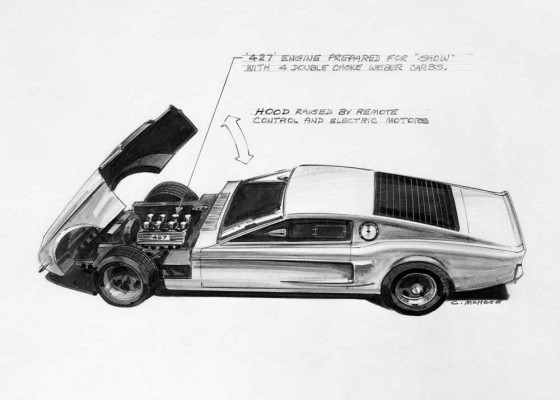Η Ford δίνει στην δημοσιότητα τα πρωτότυπο μοντέλα Mustang που δεν μπήκαν ποτέ στην παραγωγή!
Τον επόμενο χρόνο η Ford ετοιμάζεται για να γιορτάσει μισό αιώνα παρουσίας του εμβληματικού Mustang με ταυτόχρονο λανσάρισμα της νέας γενιάς. Μέχρι τότε η αμερικανική εταιρία έδωσε στη δημοσιότητα μερικά από τα concept cars όπως τα φαντάζονταν οι σχεδιαστές και μηχανικοί ανά εποχή.
Αξιοσημείωτο είναι πως κανένα από αυτά δεν βγήκε ποτέ στην παραγωγή αλλά η Ford αποφάσισε να τα κοινοποιήσει για να δείξει πως θα μπορούσε να είναι ένα Mustang. Η παραγωγή του Ford Mustang ξεκίνησε το 1964 ενώ η κεντρική φωτογραφία του άρθρου αφορά στο Mustang Mach 1 Concept που θα προλόγιζε τις αναβαθμίσεις στο επόμενο μοντέλο.
Early in the gestation of the original Mustang, Ford designers also considered a number of two-seater studies. These were seen as a more affordable return to the roots of Thunderbird, which by this time had grown into a much larger four-seater. The idea of a two-seat Mustang was something designers returned to frequently in the period between the original Mustang 1 concept and the 1992 Mach III. Aside from some track-oriented Mustangs that had the rear seats removed to save weight, there has never been a strictly two-seat production Mustang.
Ford Mustangs That Never Were: 1962 Allegro design study
Ford Mustangs That Never Were: 1963 two-seat, mid-engine coupe
1964-two-seater-study-2
1964-two-seater-study
1966-ford-mustang_mach_1_concept-1
1966-ford-mustang_mach_1_concept-2
1966-ford-mustang_mach_1_concept-3
1966-ford-mustang_mach_1_concept-4
1966-ford-mustang_mach_1_concept-5
1966-ford-mustang_mach_1_concept-6
1966-ford-mustang_mach_1_concept-7
1966-ford-mustang_mach_1_concept-8
1966-ford-mustang_mach_1_concept-9
1966-mustang-station-wagon
In 1967, Ford designers decided to reprise one of the original Mustang design concepts from 1962 with a new form and repurposed name. Starting with the Avanti/Allegro fastback coupe, the greenhouse was removed and replaced with a low-cut speedster-style windshield, rollbar, flying buttresses on the rear deck and a new rear end. The reworked concept was dubbed Allegro II.
With the Mustang having already set sales records following its launch in 1964, Ford design chief Gene Bordinat and the Special Vehicles Group decided to try rearranging the pieces for the Mach 2 concept. The 289 Hi-Po V8 was shifted from the front to behind the two seats to evaluate the layout as a possible successor to the Shelby Cobra. Despite its mid-engine layout, the Mach 2 retained the long-hood, short-deck proportions of a Mustang. Unfortunately, the Mach 2 never went much beyond the auto show circuit.
First shown publicly at the February 1970 Chicago Auto Show, the Mustang Milano concept previewed the nearly horizontal rear deck and sharp, extended nose that would be seen on the production 1971 model. However, aside from those two elements, the Milano didnÎÎβâ¬βâÎt really bear much resemblance to any production Mustang. In fact, the car that probably drew most heavily on the Milano profile was the Australian-market Falcon XB coupe of the mid-1970s.
Ford Mustangs That Never Were: 1970 Mustang Milano concept
Created at the Italian Ghia design studio, the RSX was conceived as a rally special based on the new Fox-body third-generation Mustang that debuted for the 1979 model year. With a one-inch-wider track and 5.6-inch-shorter wheelbase than the road-going Mustang, the RSX had extra ride height that would be needed for dealing with the off-tarmac stages of European rallies.
The Mach III provided the first public hints of the new design direction that was coming for the fourth-generation Mustang. While classic elements like the grille pony badge, side scoops and tri-bar taillamps were included on the 1994 Mustang, the two-seater layout and the low-cut speedster windshield have never been part of a regular production Mustang.
From late 1961 into mid-1962, Ford designers tried out a wide range of themes for a sporty coupe based on the platform of the new Falcon compact. Each design was given an internal name for the purpose of discussion. One fastback design actually went through at least three different names starting with Avventura before moving on to Avanti and finally Allegro.The fastback design was originally sketched with a hatchback and rear-facing second row seat. While this car never made it to production, a variation of the fastback profile was eventually adopted as the third bodystyle for Mustang.
Ford Mustangs That Never Were: Avanti/Allegro concept
In 1990, Ford designers evaluated a number of themes for a replacement for the long-running third-generation Mustang. The notchback and hatchback bodystyles would be replaced with a single fastback coupe format. After departing from many of the original design cues on the third-generation models, the upcoming fourth-generation would return elements like the galloping pony in the grille, the side scoops and the tri-bar taillamps. This softer concept, known as ÎÎβâ¬ÎâºBruce JennerÎÎβâ¬ÎÂ¥ wasnÎÎβâ¬βâÎt considered aggressive enough to be a Mustang.
This alternative proposal dubbed, ÎÎβâ¬ÎâºRambo,ÎÎβâ¬ÎÂ¥ was deemed too extreme for production.
